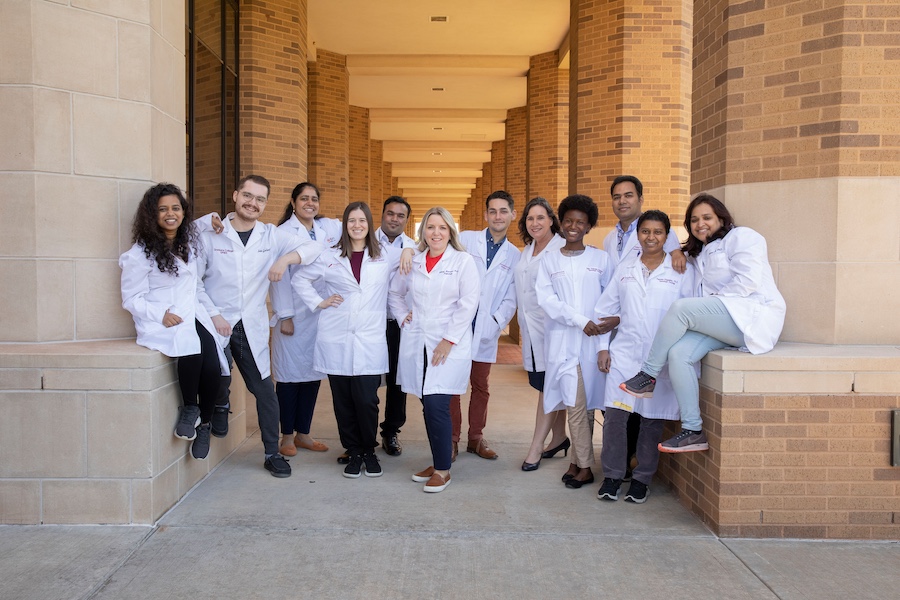2021 SGO Virtual Meeting Themes

This year’s Society of Gynecologic Oncology annual meeting was held virtually, with most sessions held March 19 to 21, 2021. The majority of sessions included pre-recorded abstract presentations followed by dynamic and engaging live Q&A. In addition to the latest research in gynecologic cancers highlighted below, several sessions included timely topics important to cancer care in general.
Annie Ellis and Kathleen Maxian, OCRA Research Advocates and ovarian cancer survivors, attended the virtual meetings and compiled the following highlights to share with the ovarian and larger gynecologic cancer community. We’re pleased to provide this window into the most exciting conversations and progress in the fields of gynecologic cancer, and are grateful for their significant efforts and commitment, which make it possible.
Impact of Covid-19 on Gynecologic Cancer Care
There were a number of presentations that focused on the impact of the Covid-19 pandemic on gynecologic cancer care and ongoing clinical trials. In response to rapidly-changing situations during the early days of the pandemic, the SGO convened a Covid-19 Task Force to develop temporary guidelines and considerations, to continue to provide the best care for patients with gynecologic cancers. By immediately adapting to the crisis, including the relaxed regulations which allowed remote monitoring and sending oral agents by mail, clinical trials in the Gynecologic Oncology Group (GOG) increased accrual by 50%. Telehealth was adopted quickly by both providers and patients and continues to be an effective way to reduce frequent office visits, especially for patients on maintenance regimens. Covid-19 has also amplified existing health disparities. Watch “Lessons from Covid-19” Video, Virtual #SGOMtg Coverage.
Addressing Healthcare Inequities
One of the most important sessions was “Eradicating Racism and Discrimination in Medicine” which included presentations from Dr. Jeffrey Hines of WellStar Medical Group, Dr. Darin Latimore of Yale School of Medicine and Dr. Erica Marsh of the University of Michigan Medical School. These experts described historical impacts of racism, systemic racism, cancer-specific disparity statistics and how unconscious bias impacts patient care. They also shared essential strategies to mitigate one’s biases. Learn more about how the SGO continues to advocate for equitable quality care.
The Promise of Artificial Intelligence
One of the most exciting sessions of the meeting was the lecture given by Dr. Eric Topol of Scripps Research Institute and author of Deep Medicine: How Artificial Intelligence Can Make Healthcare Human Again. Dr. Topol spoke about the development of artificial intelligence (AI) and smart technology to transform clinical care. AI has the potential to support quicker, more precise diagnoses as well as prioritize reasonable treatment selections, which would give back time for doctors to bring more humanity into relationships with their patients. With broad and inclusive input, AI has the potential to speed the practice of individualized medicine and overcome health disparities.
Read Article: How AI Can Bring Humanity Back to Medicine.
Platinum Resistant Recurrent Gynecologic Cancer Updates
- In a Late Breaking Abstract session, Dr. Dana Roque from the University of Maryland Medical Center presented “Randomized phase II trial of weekly ixabepilone with or without biweekly bevacizumab for platinum-resistant or refractory ovarian/fallopian tube/primary peritoneal cancer.” Ixabepilone is a microtubule-stabilizing agent approved in other cancers. In this small randomized trial, the median PFS for the combination of ixabepilone and bevacizumab was 5.5 months and ixabepilone alone was 2.2 months. The combination was considered well-tolerated and prior use of bevacizumab did not influence PFS or OS. Read “Combo Tx Active in Recurrent, Platinum-Resistant Ovarian Cancer” in MedPage Today.
- In the opening scientific session, Dr. Katherine Fuh from Washington University, St. Louis presented “Phase I study of GAS6/AXL inhibitor (AVB-500) in recurrent, platinum resistant ovarian carcinoma.” AVB-500 is an Fc fusion protein that binds the GAS6 ligand and targets GAS6/AXL pathway. In this small safety study, AVB-500was found to be safe and tolerable in combination with Paclitaxel or PLD. If validated, serum soluble AXL/GAS6 ratio may serve as a potential biomarker to identify patients most likely to benefit. Read “AVB-500/Paclitaxel Demonstrates Clinical Benefit in Platinum-Resistant Ovarian Cancer” in OncLive.
- In a Late Breaking Abstract session, Dr. Tiantian Wang of National Cancer Center in Beijing, China presented “Apatinib Combined With Pegylated Liposomal Doxorubicin (PLD) versus PLD for Platinum-resistant Recurrent Ovarian Cancer (APPROVE): A Multicenter, Randomized, Controlled, Open-label, Phase 2 Trial.” Apatinib is an oral tyrosine kinase inhibitor that inhibits VEGFR2. In this small randomized trial, the median PFS for the combination of apatinib and PLD was 5.8 months and PLD alone was 3.3 months. There was more hand-foot syndrome and hypertension with the apatinib/PLD combination. Read “Adding Apatinib to Doxorubicin for Platinum-Resistant or Refractory Ovarian Cancer Extends Time to Progression” in CancerNetwork.
PARP Inhibitors and Combination Therapies
- Dr. Joyce Liu of Dana-Farber Cancer Institute presented “An Open-Label Phase 2 Study of Dostarlimab (TSR-042), Bevacizumab (bev), and Niraparib Combination in Patients (pts) with Platinum-Resistant Ovarian Cancer (PROC): Cohort A of the OPAL Trial.” Dostarlimab is a PD-1 inhibitor. In this small study, Dostarlimab plus niraparib (Zejula) and bevacizumab (Avastin) showcased favorable antitumor activity and tolerability in patients with platinum-resistant ovarian cancer in patients with platinum-resistant ovarian cancer. (For more information see: https://www.onclive.com/view/dostarlimab-triplet-shows-antitumor-activity-tolerability-in-ovarian-cancer )
- Dr. Melissa Hardesty from Alaska Women’s Cancer Care presented “Phase 2 OVARIO Study of Niraparib + Bevacizumab Therapy in Advanced Ovarian Cancer Following Front-Line Platinum-Based Chemotherapy With Bevacizumab.” This small randomized study included stage IIIB to IV patients who achieved a complete or partial response after front line treatment. The primary endpoint was PFS at 18 months which was 625 overall, 76% for patients with Homologous Recombination deficient (HRd) cancer and 46% for Homologous Recombination proficient (HRp).
(For more information: https://ascopost.com/news/march-2021/niraparib-plus-bevacizumab-shows-clinical-benefit-in-patients-with-advanced-ovarian-cancer/ )
PARP Inhibitors Subgroup Analysis from larger studies
Data from previously reported large studies continue to be analyzed to identify patients receiving the most benefit as well as possible predictors of resistance.
- Dr. Rebecca Kristeleit, MD, PhD, from Guy’s and St Thomas’ Hospital London, United Kingdom, presented “Rucaparib vs chemotherapy in patients with advanced, relapsed ovarian cancer and a deleterious BRCA mutation: efficacy and safety from ARIEL4, a randomized phase 3 study.” Watch “Rucaparib vs. Chemotherapy in Ovarian Cancer,” and “Relapsed Ovarian Cancer: Rucaparib vs Chemotherapy.”
- Dr. Ursula Matulonis of Dana-Farber Cancer Institute presented “Long-term safety and secondary efficacy endpoints in the ENGOT-OV16/NOVA phase III trial of niraparib in recurrent ovarian cancer.” Read “ENGOT-OV16/NOVA Study Results Continue to Support Niraparib Maintenance for Patients With gBRCA+/- Ovarian Cancer,” CancerNetwork.
- Dr. William Bradley of the Medical College of Wisconsin presented “Maintenance olaparib for patients with newly diagnosed, advanced ovarian cancer and a BRCA mutation: 5-year follow-up from SOLO1.” Watch “5-Year Follow-up on Maintenance Olaparib.”
Rare Sub-Types of Ovarian Cancer
Several scientific poster sessions featured rare subtypes of ovarian cancer, including clear cell, granulosa cell tumors and mucinous tumors.
- Dr. Han Cun, MD Anderson: Clear cell ovarian tumors display a unique tumor immune microenvironment
- Dr. Rachel Soyoun Kim, University of Toronto: Impact of lymphadenectomy and intraoperative tumor rupture on survival in early-stage mucinous ovarian cancers
- Dr. Ruth Baker, University of Minnesota Medical School: Platinum refractory advanced stage ovarian clear cell carcinoma: Time to reconsider primary therapy?
- Dr. Dimitrios Nasioudis, University of Pennsylvania: Prevalence of lymph node metastasis and role of lymphadenectomy for apparent early-stage ovarian clear cell carcinoma,
- Dr. Rachek Soyoun Kim, University of Toronto: Safety of fertility sparing management in invasive mucinous ovarian carcinoma
- Dr. Austin Gardner, University of Alabama at Birmingham: The increasing incidence of granulosa cell tumors in the United States: What factors are responsible?
- Dr. Alexandra Spirtos, University of Texas Southwestern: Treatment patterns and survival outcomes of recurrent adult-type granulosa cell tumors
- Dr. Rei Christian Calma, University of Iowa Hospitals and Clinics: Utility of lymphadenectomy in mucinous ovarian carcinoma
Time to Return to the Drawing Board: Learning From Negative Trials
The low response rate to immunotherapy (compared to other cancers) has been extremely frustrating to both researchers and the ovarian cancer community. It is also frustrating when novel targeted therapies do not improve survival. In this session, early interim results and negative trials (trials that do not meet survival aims) were reported and followed by a fascinating discussion by a panel of experts. This is extraordinary, because many scientific journals and meetings do not report negative clinical trials results.
Research Advocate note: The most valuable resource is the clinical trial participant. Having this session to bring transparency, and foster open dialogue and the opportunity to learn and design better trials in the future, ensures that the efforts of every clinical trial participant adds to the knowledge that will bring more effective treatments in the future.
- Dr. Charles Landen from University of Virginia presented “Association of BRCA1/2, homologous recombination deficiency, and PD-L1 with clinical outcomes in patients receiving atezolizumab vs placebo combined with carboplatin, paclitaxel, and bevacizumab for newly diagnosed.” Atezolizumab is a PD-L1 immune checkpoint inhibitor. In this trial, the addition of atezolizumab to the treatment triplet did not increase progression free survival.
- Dr. Thomas Herzog of the University of Cincinnati Cancer Institute presented “A randomized, double-blind, placebo-controlled, Phase 2 study to assess the efficacy/safety of farletuzumab in combination with carboplatin plus paclitaxel or carboplatin plus pegylated liposomal doxorubicin (PLD) in women with low CA125. Farletuzumab is a targeted therapy targeting the folate receptor on cancer cells. In this trial there was no improvement in PFS or OS when Farletuzumab was added to chemotherapy combinations.
- Dr. Emily Hinchcliff presented “Randomized Phase II trial of Durvalumab (anti-PDL1) and Tremelimumab (anti-CTLA4) Administered in Combination versus Sequentially for the Treatment of Recurrent Platinum-Resistant non-Clear Cell Ovarian Cancer (NCT03026062).” In this trial there was no difference in progression free survival between combination and sequential treatment.
- Dr. Jung-Yun Lee of Yonsei University Health System in Korea presented “KGOG 3046/ TRU-D/ A phase II study of durvalumab and tremelimumab with front-line neoadjuvant chemotherapy in patients with advanced-stage epithelial ovarian cancer.” Durvalumab is a PD-L1 immune checkpoint inhibitor and tremelimumab is a CTLA-4 immune checkpoint blocker. This interim analysis of 23 patients showed changes in the tumor microenvironment that may increase responses to immunotherapy when combined with chemotherapy prior to debulking surgery. This trial is still accruing.
- See write-up on this topic, by survivor advocate Dee Sparacio, Women of Teal.
Neuropathy
Neuropathy is a significant treatment side effect for many ovarian cancer survivors. During a session on Reducing Therapeutic Toxicity and Optimizing Outcomes, early and ongoing work was presented, addressing screening for neuropathy-related hearing loss and identifying those most likely to develop treatment-related neuropathy.
- Jennessa Rooker, RN from Tampa General Hospital presented “Routine Early Screen for Chemotherapy-Induced Hearing Loss and other Neuropathies in Patients Undergoing Cancer Treatment: A Pilot Study.” In this small study, nurses screened patients for neuropathy prior to receiving treatment and treatment delays or dose reductions were recommended. Routing early screening has the potential to provide opportunity for interventions to improve QoL by reducing the impact of long-term side effects.
- Dr. Lauren Thomaier of the University of Minnesota presented “Genetic variants predictive of chemotherapy-induced peripheral neuropathy symptoms in gynecologic cancer survivors.” In this small study of DNA from saliva samples, 2 single nucleotide morphisms (SNPs) were shown to be associated with neuropathy. If validated, this could lead to individualized treatments and proactive strategies for patients identified most at risk for neuropathy.
Nutritional Supplements
In a session for Advanced Practice Providers, Dr. Judith Smith, a pharmacist from UTHealth McGovern Medical School in Texas, presented “Catching Up to Speed on the Role of Nutritional Supplements in the Management of Gynecologic Cancer Patients.” Approximately 20-60% of patients use supplements, sometimes in combination with cancer treatments. Dr. Smith urged doctors to have thoughtful discussions about safety and potential interactions with drugs.
Research Advocate Note: Patients should always inform their medical teams of any supplement use, because some supplements can impair liver function or may interfere with blood clotting. See more information about supplements.
Woman to Woman Program
OCRA’s Woman to Woman program was featured in a poster session by Hannah Moran of the University of Kansas School of Medicine: ‘My journey is to help somebody else:’ The session was a qualitative assessment of peer-to-peer gynecologic cancer mentorship during COVID-19.
Patient Advocates At SGO Meeting
- Patient Advocate Perk Up: For the first time, a session was devoted to patient advocates attending SGO to connect with each other and SGO/Foundation for Women’s Cancer leadership. Plans to engage patient advocates at future annual meetings are underway.
Learn more about Patient Advocates and SGO and Patient advocate membership. - Poster Session: Survivors Kathleen Maxian and Annie Ellis were part of the team presenting a poster entitled “Patients recommend patience: Ovarian cancer survivors describe the PARP inhibitor experience” which highlights results of a survey of ovarian cancer survivors who had received treatment with at least one PARP Inhibitor.


